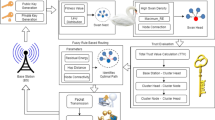Abstract
Wireless sensor networks play the most important role in the internet of things (IoT). Due to the extensive development of sensor networks, the innate limitations and characteristics of the resources in sensors, and heterogeneity of equipment, wireless sensor network has been confronted with security challenges and various vulnerabilities. One way to improve the reliability of the sensor networks is to use abnormal behaviors detection methods in the network. The current paper presents a detection method for abnormal behaviors in a distributed way using a division technique based on entropy and closeness of cumulative observation points. The proposed algorithm for detecting intrusions processed in an intranetwork manner and separates abnormal data from normal data and then classifies it and reports to the higher levels. To investigate the efficiency and accuracy of the detection, multilayer hierarchical topology and simulations based on MATLAB software were employed. The results show high accuracy of the proposed method in detecting abnormal behavior in different levels of wireless sensor networks.



Similar content being viewed by others
References
Shahid, N., Naqvi, I. H., & Qaisar, S. B. (2015). Characteristics and classification of outlier detection techniques for wireless sensor networks in harsh environments: A survey. Artificial Intelligence Review, 43(2), 193–228.
Kumarage, H., Khalil, I., Tari, Z., & Zomaya, A. (2013). Distributed anomaly detection for industrial wireless sensor networks based on fuzzy data modelling. Journal of Parallel and Distributed Computing, 73(6), 790–806.
Sherasiya, T., Upadhyay, H., & Patel, H. B. (2016). A survey: Intrusion detection system for internet of things. International Journal of Computer Science and Engineering (IJCSE), 5, 2.
Forkan, A. R. M., Khalil, I., & Atiquzzaman, M. (2017). ViSiBiD: A learning model for early discovery and real-time prediction of severe clinical events using vital signs as big data. Computer Networks, 113, 244–257.
Li, B., Lu, R., Wang, W., & Choo, K. K. R. (2017). Distributed host-based collaborative detection for false data injection attacks in smart grid cyber-physical system. Journal of Parallel and Distributed Computing, 103, 32–41.
Kumarage, H., Khalil, I., Alabdulatif, A., Tari, Z., & Yi, X. (2016). Secure data analytics for cloud-integrated internet of things applications. IEEE Cloud Computing, 2, 46–56.
Qiu, T., Chen, N., Li, K., Atiquzzaman, M., & Zhao, W. (2018). How can heterogeneous internet of things build our future: A survey. IEEE Communications Surveys & Tutorials, 20, 2011–2027.
Park, T., Cho, D., & Kim, H. (2018). An effective classification for DoS attacks in wireless sensor networks. In 2018 Tenth international conference on ubiquitous and future networks (ICUFN) (pp. 689–692). IEEE.
Moshtaghi, M., Leckie, C., & Karunasekera, S. (2016). A framework for distributed data analysis for IoT. In Internet of things (pp. 163–180).
Forkan, A. R. M., Khalil, I., & Atiquzzaman, M. (2017). ViSiBiD: A learning model for early discovery and real-time prediction of severe clinical events using vital signs as big data. Computer Networks, 113, 244–257.
Yao, H., Fu, X., Yang, Y., & Postolache, O. (2018). An incremental local outlier detection method in the data stream. Applied Sciences, 8(8), 1248.
Bosman, H. H., Iacca, G., Tejada, A., WÖrtche, H. J., & Liotta, A. (2017). Spatial anomaly detection in sensor networks using neighborhood information. Information Fusion, 33, 41–56.
Curiac, D., & Volosencu, C. (2012). Ensemble based sensing anomaly detection in wireless sensor networks. Expert Systems with Applications, 39(10), 9087–9096.
Serdio, F., Lughofer, E., Pichler, K., Buchegger, T., Pichler, M., & Efendic, H. (2014). Fault detection in multi-sensor networks based on multivariate time-series models and orthogonal transformations. Information Fusion, 20, 272–291.
Gaillard, F., Autret, E., Thierry, V., Galaup, P., Coatanoan, C., & Loubrieu, T. (2009). Quality control of large Argo datasets. Journal of Atmospheric and Oceanic Technology, 26(2), 337–351.
Giatrakos, N., Deligiannakis, A., Garofalakis, M., & Kotidis, Y. (2018). Omnibus outlier detection in sensor networks using windowed locality sensitive hashing. Future Generation Computer Systems.
Suthaharan, S., Leckie, C., Moshtaghi, M., Karunasekera, S., & Rajasegarar, S. (2010). Sensor data boundary estimation for anomaly detection in wireless sensor networks. In 7th International conference in mobile adhoc and sensor systems (MASS) (pp. 546–551). IEEE.
Kumarage, H., Khalil, I., & Tari, Z. (2015). Granular evaluation of anomalies in wireless sensor networks using dynamic data partitioning with an entropy criteria. IEEE Transactions on Computers, 64(9), 2573–2585.
Giatrakos, N., et al. (2018). Omnibus outlier detection in sensor networks using windowed locality sensitive hashing. Future Generation Computer Systems.
Forkan, A. R. M., Khalil, I., & Atiquzzaman, M. (2017). ViSiBiD: A learning model for early discovery and real-time prediction of severe clinical events using vital signs as big data. Computer Networks, 113, 244–257.
Ahmad, B., Jian, W., Ali, Z. A., Tanvir, S., & Khan, M. S. A. (2019). Hybrid anomaly detection by using clustering for wireless sensor network. Wireless Personal Communications, 106(4), 1841–1853.
de Souza, P. S. S., Rubin, F. P., Hohemberger, R., Ferreto, T. C., Lorenzon, A. F., Luizelli, M. C., & Rossi, F. D. (2020). Detecting abnormal sensors via machine learning: An IoT farming WSN-based architecture case study. Measurement, 164, 108042.
Poornima, I. G. A., & Paramasivan, B. (2020). Anomaly detection in wireless sensor network using machine learning algorithm. Computer Communications, 151, 331–337.
Chen, Y., & Li, S. (2019). A lightweight anomaly detection method based on SVDD for wireless sensor networks. Wireless Personal Communications, 105(4), 1235–1256.
Author information
Authors and Affiliations
Corresponding author
Additional information
Publisher's Note
Springer Nature remains neutral with regard to jurisdictional claims in published maps and institutional affiliations.
Rights and permissions
About this article
Cite this article
Arkan, A.S., Ahmadi, M. Entropy-Based Anomaly Detection Using Observation Points Relations in Wireless Sensor Networks. Wireless Pers Commun 119, 1783–1798 (2021). https://doi.org/10.1007/s11277-021-08306-5
Accepted:
Published:
Issue Date:
DOI: https://doi.org/10.1007/s11277-021-08306-5




